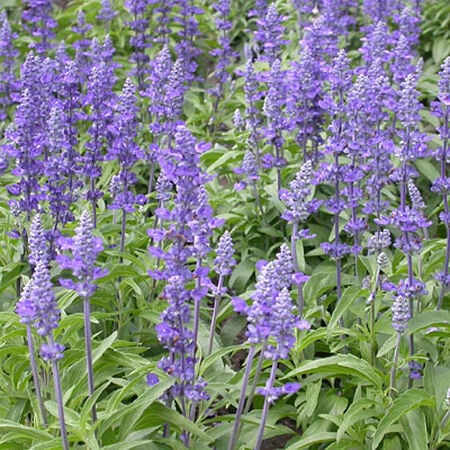Victoria, Salvia Seeds
Key Attributes
Key Attributes
Product Details
Weight
0.008Depth
0.1Height
4.5Width
3.25Plant Height
18-24"Botanical Name
Salvia farinaceaSeed Type
SeedAdditional Characteristics
Attracts Pollinators, Attracts Birds, Deer ResistantSeeds Per Gram
840Seeds Per Pound
380,800Packet
50 SeedsSow Depth
1/8"Seeds Per Ounce
23,800Breed
Open-pollinatedSun
Full SunGrowing Conditions
ContainerUses
Cut Flowers, Dried ArrangementsLife Cycle
Tender PerennialSow Method
TransplantCategories
FlowersDays To Maturity (# Days)
125Components
Growing Instructions
![]() Learning Download: How to Grow Salvia
Learning Download: How to Grow Salvia
Salvia blooms are spiky flowers that grow on bushy plants. They can reach 10 to 60 inches in height, but most varieties are below 36 inches.
Before Planting: Salvia grows best in full sun, and it grows well in average to good soil with a pH of 5.5 to 6.5.
Planting: Direct sow seeds and space 10 to 20 inches apart depending on the variety and its size.
Watering: Water once or twice during the week.
Fertilizer: Once it is established, cut the flowers back each fall and apply a balanced fertilizer in the spring.
Days to Maturity: Salvia blooms from late spring to early summer.
Harvesting: When bringing the fresh flowers inside to display, remove any leaves or blossoms that will be underwater. Salvia’s leaves can be harvested for herb use in culinary dishes.
Tips: Apply a 2-inch layer of mulch around the plants to retain moisture and deter weeds.
Shipping Schedule
Our Seed Promise
 "Agriculture and seeds" provide the basis upon which our lives depend. We must protect this foundation as a safe and genetically stable source for future generations. For the benefit of all farmers, gardeners and consumers who want an alternative, we pledge that we do not knowingly buy or sell genetically engineered seeds or plants.
"Agriculture and seeds" provide the basis upon which our lives depend. We must protect this foundation as a safe and genetically stable source for future generations. For the benefit of all farmers, gardeners and consumers who want an alternative, we pledge that we do not knowingly buy or sell genetically engineered seeds or plants.
The mechanical transfer of genetic material outside of natural reproductive methods and between genera, families or kingdoms, poses great biological risks as well as economic, political, and cultural threats. We feel that genetically engineered varieties have been insufficiently tested prior to public release. More research and testing is necessary to further assess the potential risks of genetically engineered seeds. Further, we wish to support agricultural progress that leads to healthier soils, to genetically diverse agricultural ecosystems, and ultimately to healthy people and communities.
To learn more about the "Safe Seed Pledge" please visit www.councilforresponsiblegenetics.org.

